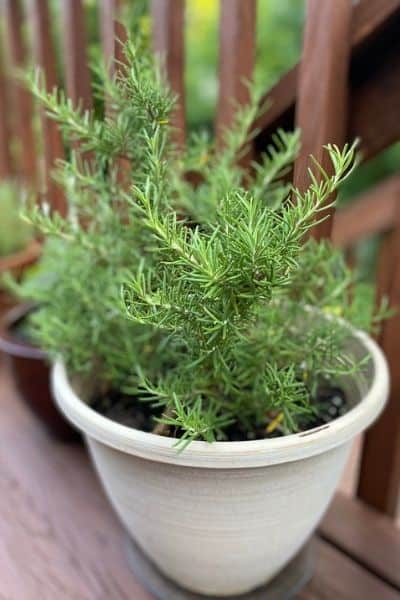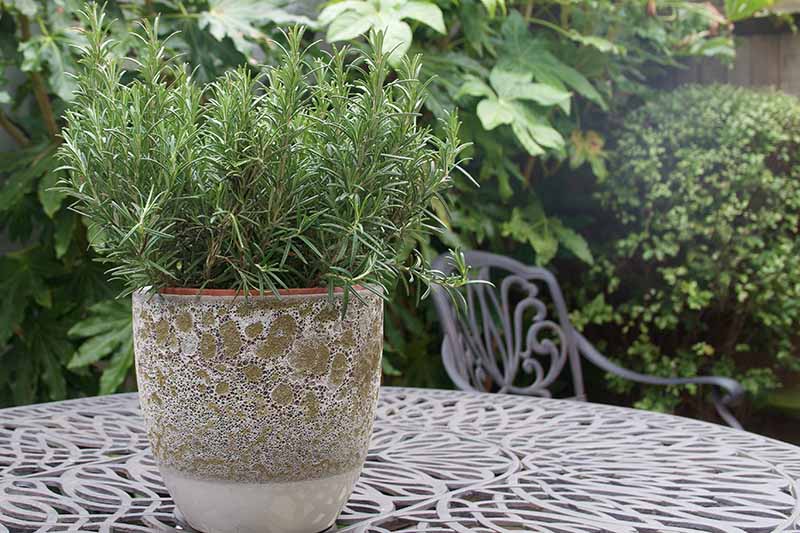
The most ideal containers for growing rosemary are clay and terracotta pots that are at least 12 inches across. They do not heat up as rapidly in the summer compared to plastic or metal pots, and they offer better protection from frost in the winter since clay and terracotta are porous and allow the soil to dry after watering.
A porous material like clay or terracotta is best because it allows the soil to dry out effectively after rainfall, in contrast to plastic pots which are not breathable and can retain too much moisture for the rosemary to tolerate. Rosemary is a Mediterranean herb that has adapted to resist drought and prefers the soil to dry out somewhat between bouts of watering.
Continue reading to find out which pots and containers work best for producing rosemary as well as how to avoid the most typical gardening blunders…
Table of Contents
Best Pot Size for Growing Rosemary
Different types of rosemary can grow up to 2 or 3 feet wide (like “Tuscan blue”), while other cultivars stay considerably more compact with annual pruning.
However, even if you have a smaller type of rosemary or if the rosemary grows at an early stage of growth, I advise that you plant your rosemary in a container that is at least 12 inches wide and the same proportionate depth.
It is crucial to plant rosemary in a pot or container that is at least 12 inches in diameter because the pot needs to have the capacity to store enough soil to keep the rosemary’s roots warm in the winter and prevent the pot from drying out too rapidly in the midst of the summer.
Additionally, a 12 inch pot has enough space for the rosemary’s roots to spread out and gain access to the nutrients and moisture it needs to thrive and maintain its health.
Because rosemary is a Mediterranean plant that is acclimated to good-draining circumstances, which helps to prevent root rot, rosemary of all types grow very well in pots and as pots have more favorable drainage conditions than garden boarders and flower beds.
Being a Mediterranean plant, rosemary grows, smells, tastes, and blooms best in full sunlight.
However, full sun can significantly speed up the rate at which pots dry out on the hottest days. For this reason, it’s crucial to use a larger pot with adequate soil capacity because pots smaller than 12 inches can dry out so quickly that rosemary roots won’t have enough time to absorb the moisture they require.
The root structure of the rosemary is generally raised above ground by pots, which might expose the roots to cold temperatures in the winter.
The component of the rosemary plant that is most vulnerable to cold is the roots. In most cases, the soil around a plant functions as insulation against the cold to keep the temperature at a level that the roots can endure in the winter.
Because there is not enough soil in a small pot to adequately protect the roots from the worst of the cold, your rosemary may die back in the winter.
In regions with colder winters, a larger pot contains enough soil to insulate the roots and shield them from frost so that they survive and bloom well the next year.
(Read my post on the ideal potting soil for rosemary.)
Best Material Rosemary Pots
Rosemary plants can flourish in ceramic, clay, terracotta, metal, and plastic containers.
However, due to the material’s efficiency at conducting heat from the sun, metal pots (such as the ones in the photo) and to some extent thin plastic pots tend to heat up more quickly in the sun.
Overheating the pot can stress the roots, evaporate water from the soil too quickly, bake the dirt hard, and prevent the rosemary’s roots from absorbing any moisture.
In the right climate and if the pot is large enough so that it does not dry out as much in the hot sun, rosemary—which is adapted to tolerating drought conditions—might be able to grow in metal or plastic pots without a problem. Rosemary is native to the Mediterranean region of Europe, where it tolerates hot and dry Summers.
To prevent your rosemary from experiencing drought stress, you must water it more frequently if the pot is radiating heat throughout the day. In contrast, rosemary loves dryer soil conditions, thus overwatering can cause root rot, which makes it challenging to provide the right amount of moisture for rosemary in metal and plastic containers.
(Read my post to find out how frequently to water rosemary.)
Terracotta or glazed clay pots are my personal picks for the best pots for growing rosemary.
When growing rosemary, root rot is the most frequent issue. These pots are more resistant to the elements than plastic or metal pots, but they are also porous and breathable, allowing damp soil to dry somewhat after a bout of heavy rainfall.
The finest containers for growing rosemary are those made of clay and terracotta. Metal and plastic pots and plants are much thinnerly manufactured than clay and terracotta pots. This implies that they withstand soil baking or rapid heating in the summer and that they resist frost damage to the roots of the rosemary in the winter.
While clay and terracotta are the greatest containers for rosemary, it’s necessary to keep in mind that they can become rather heavy compared to plastic and metal containers, especially when the plant itself and potting soil are added.
In regions with cold winters, some rosemary types may need to be placed indoors over the winter to avoid frost damage.
A lighter plastic pot, ideally in a light color (so it reflects light instead of absorbing light and heat), may be a better option because moving your pots indoors every day can be challenging.
(Read my post on maintaining rosemary plants in pots.)
Good Drainage is Key for Rosemary Pots and Containers

Without drainage holes, water will pool at the bottom of the pot and become saturated in the soil surrounding the rosemary plant’s roots, which will encourage root rot and cause the plant to become yellow, brown, or black and wither away.
(Read my essay on how to save a rosemary plant from extinction.)
It is crucial to stress that drainage holes must be kept free of debris in order for water to easily drain away from the roots.
The easiest technique to guarantee that the drainage holes stay clear is to put a 1 inch layer of gravel on the bottom of the pot before adding potting soil because dirt can become compacted in pots over time.
As soil compacted at the base might cause water to flow slowly and result in soggy conditions, the gravel maintains a porous, aerated structure at the base of the pot to allow water to drain away quickly.
Putting potted rosemary on ornamental pot “feet” or stands to lift the pot off the ground is another great practice.
If your pot is on a patio, this keeps water from pooling underneath it, which could keep the soil at the bottom too wet for rosemary, which needs the soil to dry out between waterings.
Avoid Making This Common Error!
When people plant rosemary in pots, a common error I observe is that they select the proper sort of pot but fail to provide adequate drainage in the base, then they lay the pot on a tray to prevent water from leaking onto their patio when they water the rosemary.
For this reason, if the pot is on a tray with water around the base, it is not in the ideal circumstances for rosemary, which can lead to root rot. Rosemary is native to the Mediterranean region of Europe and prefers dryer soil conditions than most plants.
Key Takeaways:
- The finest containers for growing rosemary are those made of clay and terracotta. Clay and terracotta pots are more permeable than plastic and metal pots, allowing the soil to dry out more quickly. They also do not heat up quickly in the sun and do not crack under the weight of frost, which can damage the roots of rosemary throughout the winter.
- 12 inch-wide clay and terracotta pots can carry enough soil for the rosemary root system to grow and offer adequate insulation to safeguard the rosemary roots from the cold.
- In order to prevent root rot, rosemary should only ever be planted on containers with drainage holes in the bottom.
- Keep your rosemary off of trays since they gather water, keep the soil wet, and encourage root rot. The easiest way to ensure proper drainage and avoid root rot is to set your pot on supports.
